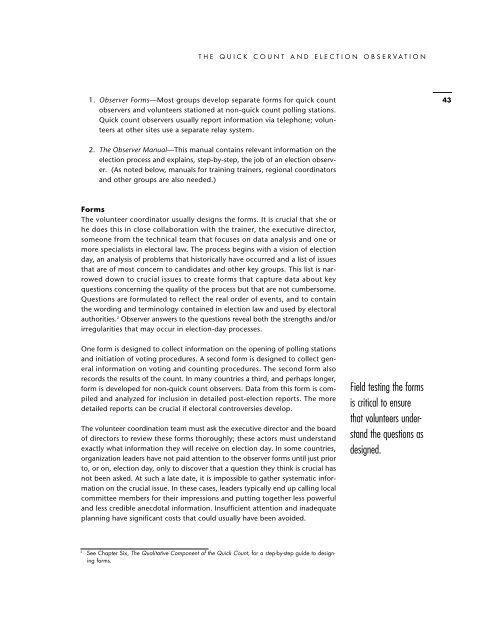The Quick Count and Election Observation
The Quick Count and Election Observation
The Quick Count and Election Observation
You also want an ePaper? Increase the reach of your titles
YUMPU automatically turns print PDFs into web optimized ePapers that Google loves.
THE QUICK COUNT AND ELECTION OBSERVATION<br />
1. Observer Forms—Most groups develop separate forms for quick count<br />
observers <strong>and</strong> volunteers stationed at non-quick count polling stations.<br />
<strong>Quick</strong> count observers usually report information via telephone; volunteers<br />
at other sites use a separate relay system.<br />
43<br />
2. <strong>The</strong> Observer Manual—This manual contains relevant information on the<br />
election process <strong>and</strong> explains, step-by-step, the job of an election observer.<br />
(As noted below, manuals for training trainers, regional coordinators<br />
<strong>and</strong> other groups are also needed.)<br />
Forms<br />
<strong>The</strong> volunteer coordinator usually designs the forms. It is crucial that she or<br />
he does this in close collaboration with the trainer, the executive director,<br />
someone from the technical team that focuses on data analysis <strong>and</strong> one or<br />
more specialists in electoral law. <strong>The</strong> process begins with a vision of election<br />
day, an analysis of problems that historically have occurred <strong>and</strong> a list of issues<br />
that are of most concern to c<strong>and</strong>idates <strong>and</strong> other key groups. This list is narrowed<br />
down to crucial issues to create forms that capture data about key<br />
questions concerning the quality of the process but that are not cumbersome.<br />
Questions are formulated to reflect the real order of events, <strong>and</strong> to contain<br />
the wording <strong>and</strong> terminology contained in election law <strong>and</strong> used by electoral<br />
authorities. 2 Observer answers to the questions reveal both the strengths <strong>and</strong>/or<br />
irregularities that may occur in election-day processes.<br />
One form is designed to collect information on the opening of polling stations<br />
<strong>and</strong> initiation of voting procedures. A second form is designed to collect general<br />
information on voting <strong>and</strong> counting procedures. <strong>The</strong> second form also<br />
records the results of the count. In many countries a third, <strong>and</strong> perhaps longer,<br />
form is developed for non-quick count observers. Data from this form is compiled<br />
<strong>and</strong> analyzed for inclusion in detailed post-election reports. <strong>The</strong> more<br />
detailed reports can be crucial if electoral controversies develop.<br />
<strong>The</strong> volunteer coordination team must ask the executive director <strong>and</strong> the board<br />
of directors to review these forms thoroughly; these actors must underst<strong>and</strong><br />
exactly what information they will receive on election day. In some countries,<br />
organization leaders have not paid attention to the observer forms until just prior<br />
to, or on, election day, only to discover that a question they think is crucial has<br />
not been asked. At such a late date, it is impossible to gather systematic information<br />
on the crucial issue. In these cases, leaders typically end up calling local<br />
committee members for their impressions <strong>and</strong> putting together less powerful<br />
<strong>and</strong> less credible anecdotal information. Insufficient attention <strong>and</strong> inadequate<br />
planning have significant costs that could usually have been avoided.<br />
Field testing the forms<br />
is critical to ensure<br />
that volunteers underst<strong>and</strong><br />
the questions as<br />
designed.<br />
2<br />
See Chapter Six, <strong>The</strong> Qualitative Component of the <strong>Quick</strong> <strong>Count</strong>, for a step-by-step guide to designing<br />
forms.


